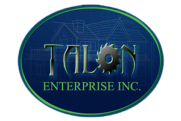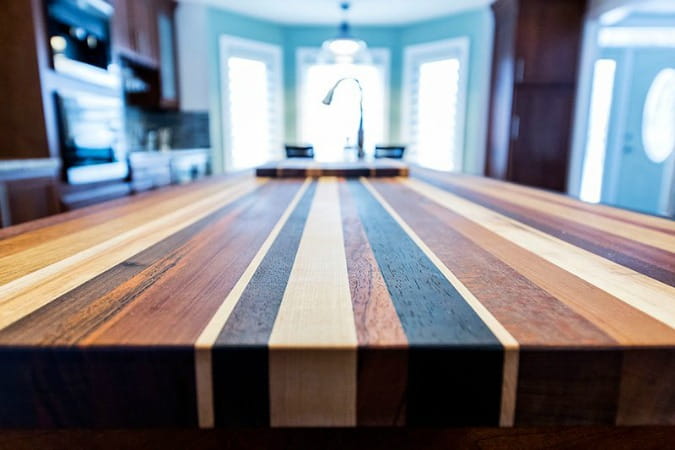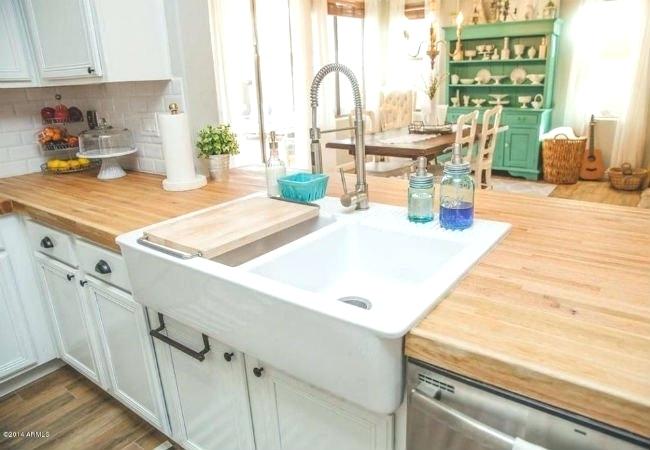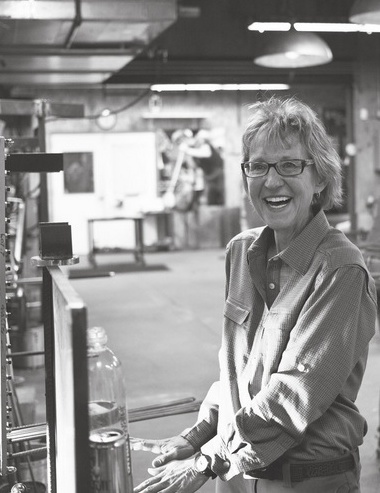How To Budget A Kitchen Remodel And What To Expect In Return
Add Your Heading Text Here
We reached out to Ron Upshaw, Seattle Real Estate broker and co-host of the Ron and Don radio show and here’s what he told us.
“In my experience, if you could only afford one improvement to your home, upgrading the kitchen – even a little bit, is the way to go.”
Whether you are thinking of selling your home and wish to increase its market value, buying a house that you wish to remodel, or it’s just time to update the kitchen & bathroom for your own enjoyment the question of cost is where most people start.
There’s such a wide range for each and every part of a kitchen. Some choices may even affect the other parts of the project, by triggering a consequential upgrade.
Be that as it may, we are going to be focused on some popular choices and styles that are commonly requested. We can’t begin to cover everything in one topic, so we will stay away from the super low and ultra high end examples for the most part.
We will be looking at what goes into a kitchen rehab, and breaking down the choices with regards to how they affect the final cost of the entire project. This subject has been covered by many experts with a wide range of opinions because there are so many variables. Yet the answers found online vary greatly. This is due in part to rising costs and regional differences.
In this post, we will take a look at the different options and what you can expect to pay in the greater Seattle area. Seattle prices are higher than the national average for a variety of reasons, which we will touch on at the end. Because we are based here, we can speak from our direct experience. We offer this information in the hopes that it helps you understand how to better budget for a project like this.
Pro Tip:
It’s always a good idea to have a contingency buffer in your budget. 10-15% is a good margin. You never know what you will find when you start to open up walls or floors inside an older house. It’s better to plan for the worst, and hope for the best.
Quick Note:
The prices we list of individual items might be higher than you can find if you’re doing a total remodel. This is in part because if you hire someone to do just one part of the job, you’re going to pay a bit more for their time than if they’re doing all of the work. The other reason is that we tried to err on the side of caution so you don’t under budget and end up spending more.
Overview:
- Total Costs. Ballpark figures for 3 different types of remodels and the average cost
- ROI. What you can expect with regards to property value
What's not covered in this article
Open Kitchen Design VS Existing Footprint.
Probably the biggest factor that needs to be taken into account when trying to factor a budget, will be keeping within the existing footprint or moving walls around. The “open kitchen” design has gained a lot of popularity since most Seattle homes were originally built. Because we spend so much of our time in our kitchens, it makes sense to open them up to the rest of the house.
No two projects will be the same, so the cost of changing the layout of a house can vary widely. Without specifics, it’s practically impossible to predict the costs associated with this type of remodel. Moving (or removing) walls almost always requires an architect, engineer, and obtaining permits. So for the sake of this comparison, we will stick to discussing kitchen renovations that stay within the existing footprint.
Design Services.
Along those same lines, we won’t be covering the cost of a designer here. Professional kitchen design is a service that we offer, and something you may want to consider for the best results.
Out with the old (Demolition)
The first part of any significant remodel is the demolition phase. Since most kitchen remodels include new cabinets, countertops and appliances we need to remove all of those in order to make preparations for the new design.
This will take 1 or 2 days on average. With labor and dump fees you can probably expect to pay anywhere from $1500-2500. This range depends on how much is removed, and how it is integrated with the rest of the house. If you plan to go down to the subfloor, you should budget up to $3500 depending on square footage and the materials that need to be removed. (Eg. Tile floors take more time to remove and weigh more at the dump compared to wood flooring)
PRO TIP: If your old appliances are still working you can keep them, or sell them second hand to recoup some of your costs. You may not get much for them, but every bit helps and you will keep them from going to a landfill. The same goes for your cabinets if they are still in good shape. However, you should ask your contractor to “deconstruct” the kitchen rather than “demo” it. If selling your old stuff is not an option you want to explore, you can also donate them to places like Habitat for Humanity. They may even pick them up for you at no charge as we discussed in this article.
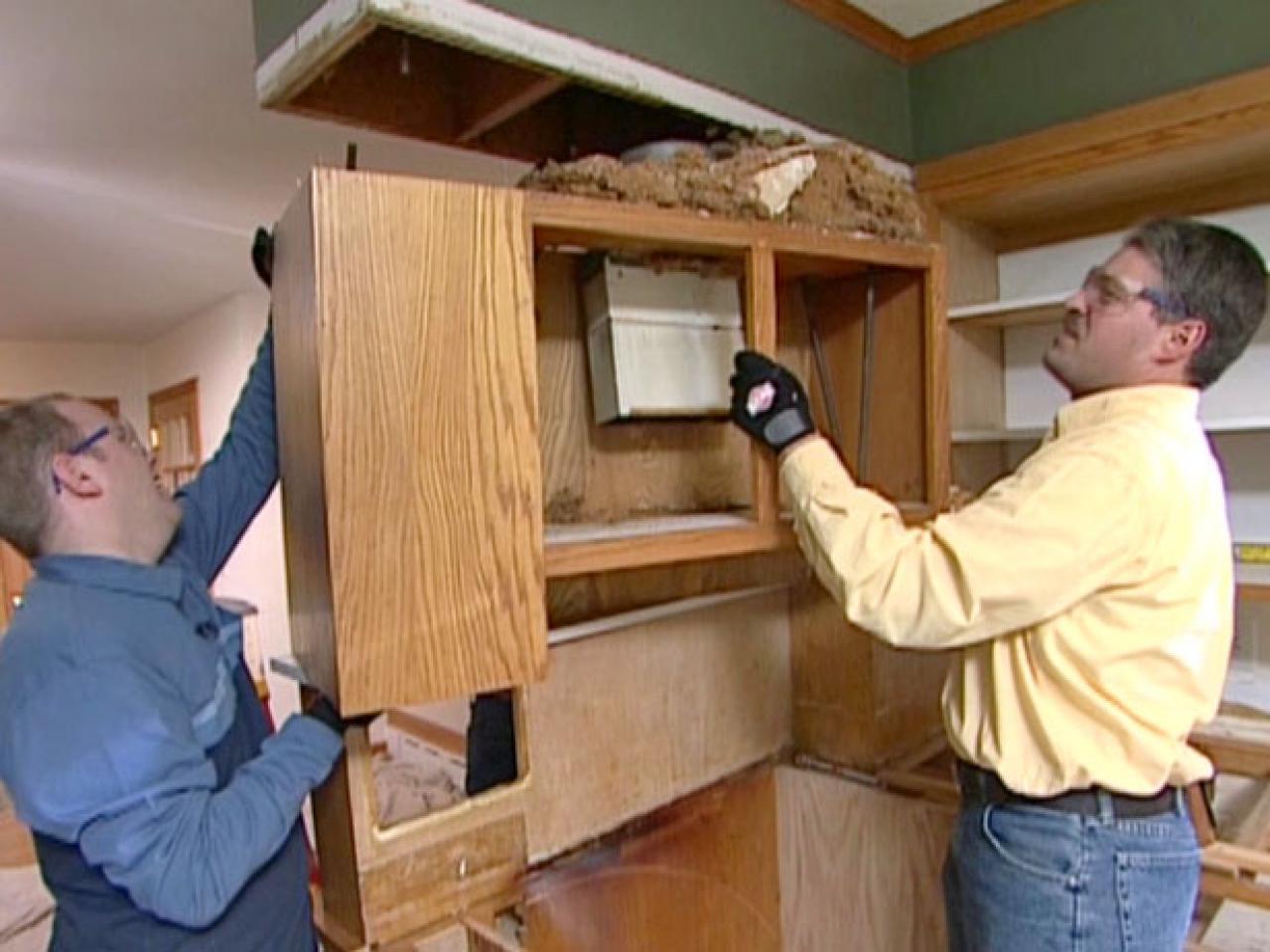
In with the new (Build Phase)
Now that the kitchen is empty, we need to fill it with your new choices. Once again, the choices can range from simple ‘off the shelf’ options, to custom designed items made of fine quality with all the bells and whistles.
Cabinets
Pre-fab
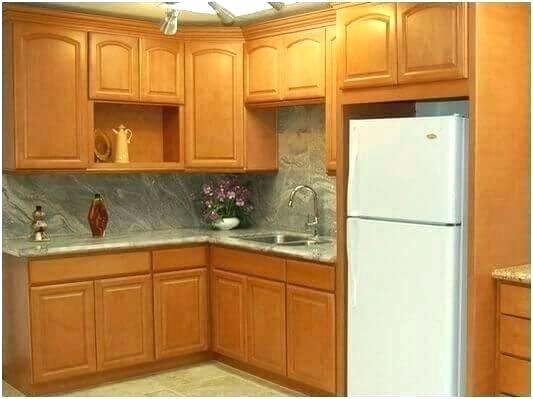
VS
Custom
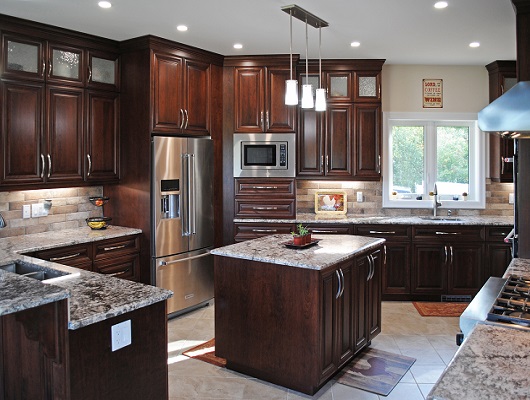
Pre-fab ‘off the rack’ options
On the lower end of the budget range you have pre-fab cabinets from big box retailers like Home Depot and Lowes. These will come in a variety of lower and upper units, pre-assembled and ready to be installed with almost no wait time. The range of options is limited compared to custom cabinets, but if you’re on a tight budget or a time crunch this choice may make sense for you.
Besides some sacrifices in quality, you should be prepared for a lower expectation when it comes to service if you go this route. If you’ve ever shopped at places like Home Depot, you may already know that finding knowledgeable experts who have time to attend to your needs can be hit and miss.
While you may be able to return items that are the wrong size, or go back to get the matching toe-kicks and trim pieces, your installers won’t appreciate waiting. They may even bill you for lost time while waiting for everything to be ready for them. It can also be an inconvenience if it means waiting longer than expected for your kitchen to be ready. This may sound trivial, but you will grow tired of eating take out and Pizza delivery if the project carries on for too long.
For the average sized kitchen (without an island) you might expect to pay $2500 to $3000 for off the shelf cabinets with matching trim pieces.
Custom cabinets
This is the option that we usually recommend for most of our clients. You will have many more options to choose from to find your perfect style, color, hardware, and configuration. The sales staff will work with you on your design features, and have a lot of helpful suggestions about things you may not have considered.
What you can be sure of, is that you will get exactly what you ordered and it will be a complete package. They may even throw in extras with regards to trim pieces and spare parts so there is no hiccup when it comes to installation. The professionals we work with are a full service operation and you will be well taken care of.
For an average kitchen you can expect to pay $4000-5000 in the mid range. It’s also possible to spend $6000 and up for some of the bells and whistles with high grade finishes or details. If your design includes an island, you might want to budget somewhere between $750-1500 extra.
Regardless of which cabinets and hardware you choose, they still need to be installed. Installation will take anywhere from 1-3 days (2 on average) with a crew of 2-3 workers. You can estimate a range of $1800-3000 for a decent size kitchen. Again, without specifics it’s hard to give an accurate cost on this because every project, every kitchen, and every client is different.
Countertops
There are a lot of options when it comes to countertops, and naturally each comes with its Pros and Cons.
We are going to take an in depth look at some common choices. But if you’re looking for a short answer, a budget of $5000-8000 (installed) for a mid sized kitchen will be enough for a popular choice like granite or quartz.
Laminate
Most of the kitchens we remodel, we are asked to tear out the old laminate countertops and replace it with a higher quality product. That said, there are some situations where laminate still makes sense. Most of the time, a new laminate countertop is used when upgrading the kitchen of a rental property, or by clients with a limited budget. Other times we have seen this used by people ‘flipping’ a property of lower value when they want to get it listed on the market as quickly as possible. Here are some Pros and Cons of laminate.
- Budget friendly
- No wait time (Compared to stone)
- Stain resistant
- Easy to install (even for an experienced DIY carpenter)
- Less desirable (lower resale value)
- Easily damaged by heat and sharp objects
- Can peel over time
- Not waterproof at the edges
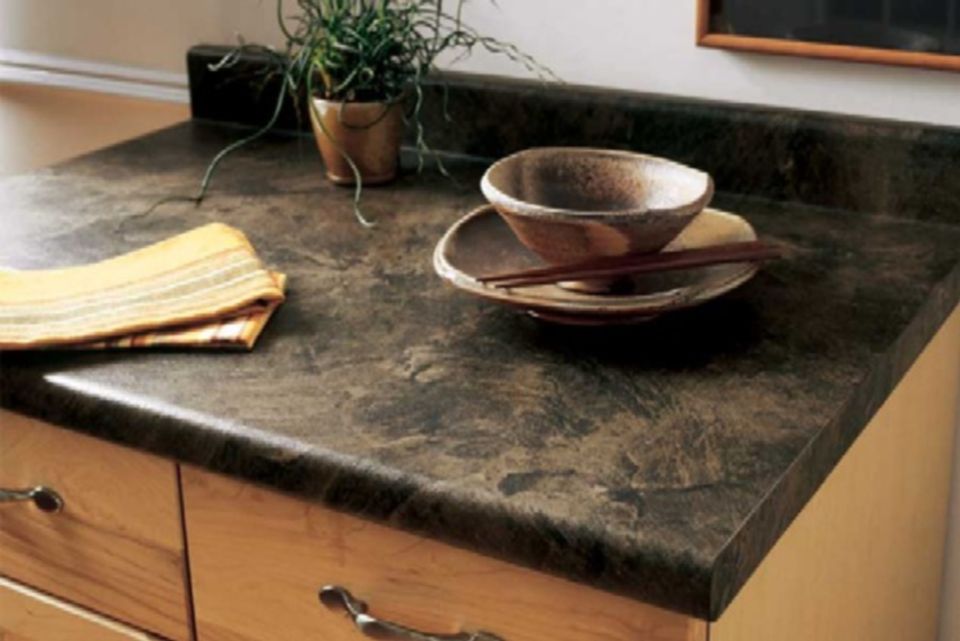
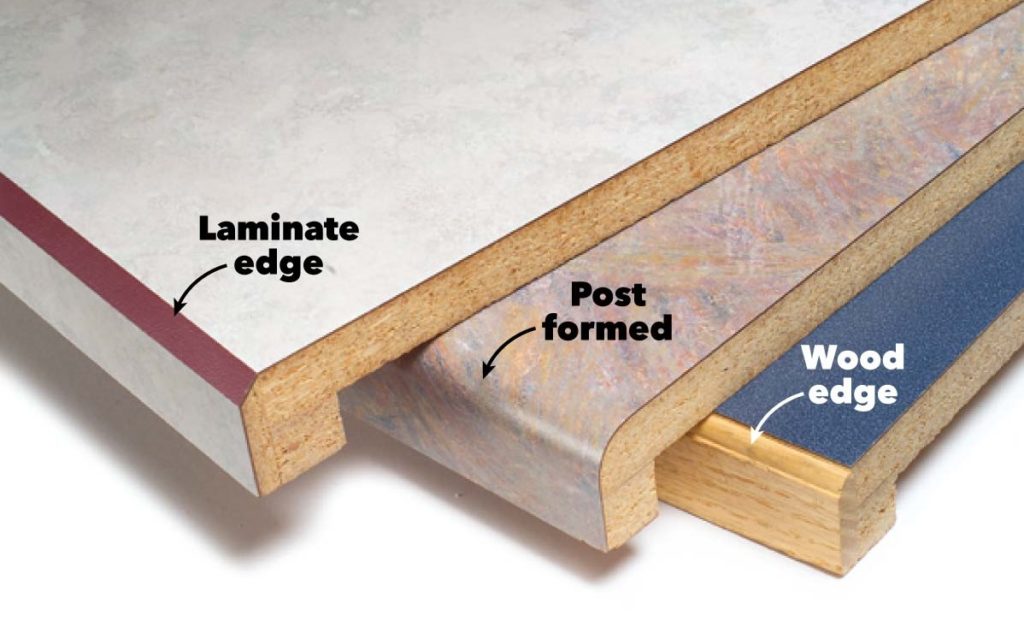
Stone Countertops
When it comes to stone countertops you have two popular options.
Quartz vs Granite (with Marble being a close 3rd and similar to Granite)
Before we talk about cost, let’s look at these popular options and the pros and cons of each.
Granite
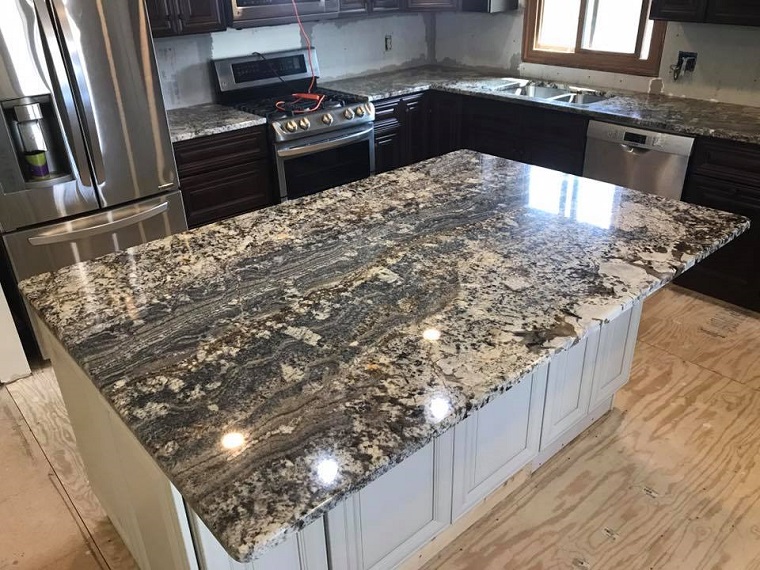
Granite is 100% natural, made by the cooling of molten materials in the earth. It’s a very hard stone that’s mined from quarries all around the world, therefore no two pieces of granite will look alike.
Granite is more likely to stain or chip, but it’s more resistant to heat and won’t fade from years of direct sunlight on the same spot like Quartz. It’s also slightly cheaper and seams can be less noticeable when compared with lighter shades of quartz.
Pro Tip: If you decide to go with granite, ask if you can pick out your slab from a stone yard. This will avoid any surprises when your countertop arrives compared to the samples you see. The slab you receive may be close to the sample, but all granite will have naturally occurring variations.
Quartz
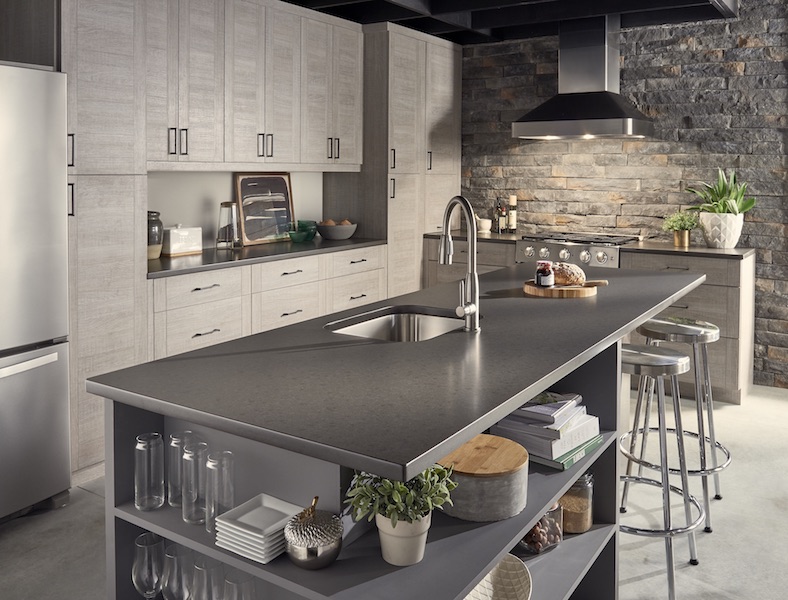
Quartz countertops are a manufactured product that use 95% ground natural quartz, and 5% polymer resins. Unlike Granite, it comes in a virtual endless variety of colors and patterns that can be replicated. Quartz is actually harder than granite and doesn’t need to be sealed every year, but you do need to be careful when it comes to sustained UV rays and heat because it can be damaged by very hot pans.
Generally quartz is 20-40% more expensive than granite. One advantage of quartz is that it’s not porous, so it’s easier to keep bacteria free and less likely to stain. It also has the ability to be manufactured in long sections which may mean less seams.
Most of the time it’s going to come down to preference. When you talk to your stone specialist they are going to have a few questions to start out. Regardless of material or colors, some of the options are going to be:
- Thickness
- Edge details
- Seams or seamless
- Overhang distances
- Backed with a sub-counter (such as plywood) or full thickness
So, having said all of that, you’re still here to find out about costs. Right?
Basic granite can start at around $40-50 per square foot and go as high as $200+.
Quartz will generally start at around $75 a square foot and top out at around $180.
Stainless steel
If you love the gleam of steel or the look of a commercial kitchen, you may want to opt for a Stainless Steel countertop. While less common in homes, it’s shine does appeal to some home chefs. It’s sometimes used in combination with other materials and can make a great centerpiece for an island top. This is especially true with a cook-top range inset into the island. Stainless Steel is very easy to keep clean, requires no real maintenance, and is virtually indestructible. All but the deepest scratches to Stainless Steel can easily be buffed out by homeowners.
For a quality custom Stainless Steel countertop you can expect to spend $80 a square foot on the low end, and up to $225 on the higher end. If this is something you’re thinking about, we suggest you budget for around $130 per sq ft until you talk to a fabricator. The installation process is fairly simple, so this option should have a lower labor cost to install.
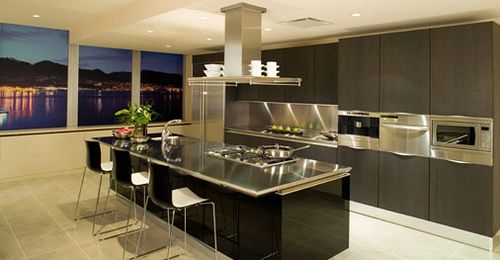
Butchers Block
If you like the classic appeal of wood, a butchers block my be a great option for you. It’s warm and forgiving surface brings a traditional look in some kitchens. It can also look ultra modern when paired with complementary finishes.
Pros:
You can cut directly on it without dulling your knives, and it can be sanded and refinished in place. It’s softer than stone so dishes are less likely to break on it and your kitchen will be quieter.
Cons:
If you do use it as your chopping block it will show signs of wear much faster. It’s also very susceptible to high heat and will fade over time in direct sunlight. Depending on the finish you choose, it can also stain quite easily. Wood countertops can require more maintenance compared to quartz or granite, but it’s worth it if that’s the look you want.
Butchers block countertops are fairly affordable and easy to shop around for. Prices can start from $40 to $60 per square foot. It’s possible to pay less if you find a good deal on one off the shelf or from a reclaim shop. One nice aspect of butcher blocks will be that your contractor is well equipped to cut them to fit your kitchen without the need for a special installer.
Go Green!
If you like wood and you’re looking for a very Green option, you may want to consider a Bamboo countertop. It’s much like a traditional butchers block, but more sustainable and environmentally friendly.
Tile countertops
While most people have moved away from tile countertops, it’s still a viable option. With some of the same qualities of stone, it can be much less expensive. One advantage of tile over a solid stone countertop, is if it should ever crack, you can replace the broken piece without removing the entire counter.
Depending on your choice of tile, a typical countertop can cost $35-50 per square foot. That price includes installation.
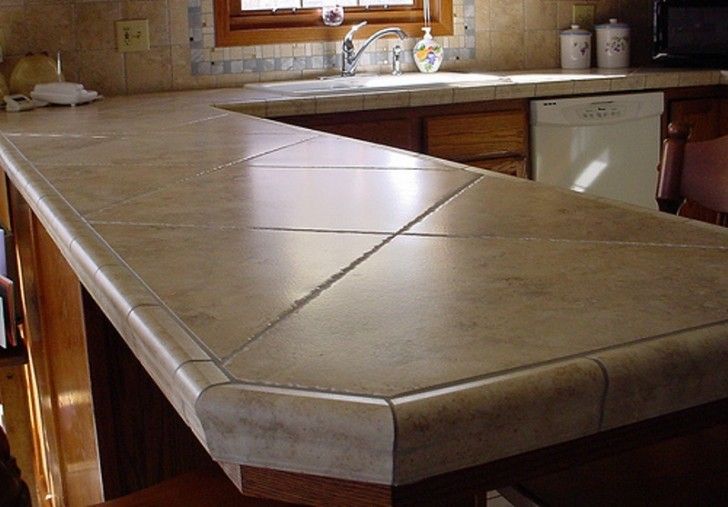
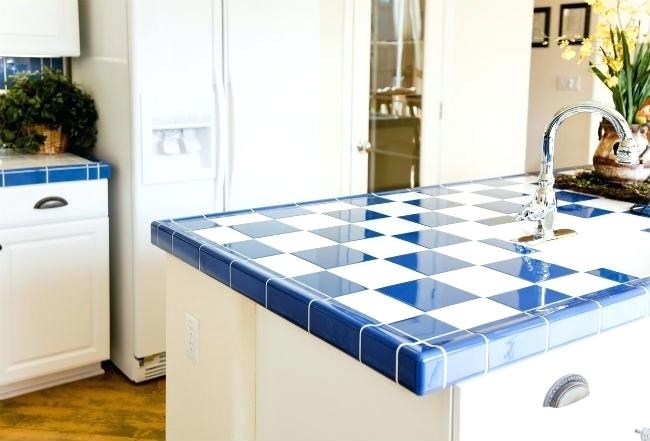
Pro Tip: If you choose a tile countertop, we highly recommend using epoxy grout rather than traditional grout. Yes it will cost a bit more and can be tricky to work with, but it doesn’t have to be sealed, and it’s very hard to stain with normal kitchen use. We also recommend keeping a few spare tiles should you ever need to make repairs.
Appliances
Once again there is going to be a huge range of options. The nice part about pricing appliances is that you can shop around online. If you’re comparing the same model from two different suppliers, you will know who’s giving you the best deal. Just be sure that they stand by their warranty.
Overall you can spend anywhere from $2500 to almost $7000 (or more) on appliances. That’s a big range so let’s break it down and take a closer look.
You can buy appliance packages which start from as low as $2000. Higher end models will run you closer to $5000. These packages commonly include a fridge, range, dishwasher, and microwave.
Buying a package can save you money if you are happy with all the models included. If you’re looking at appliances individually, here are some budgeting guidelines that might be helpful.
Electric ranges can run from $600-1500
Gas ranges can cost anywhere from $700-2600+
Refrigerators. A quality fridge can be $1000-2600+
Dishwashers range from $350-1000. A budget of $650 should cover most people’s needs.
Hood vent (wall mounted) are $150-$750. We suggest a budget of $350
Microwaves (mounted over the range) cost between $150-450. We would budget around $300
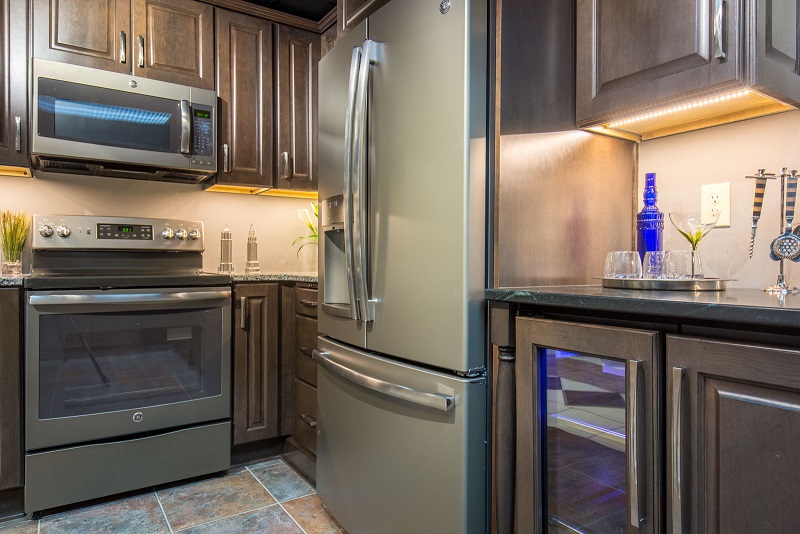
Pro Tip: A microwave / hood vent combo might cost $500-800 (or more) but it’s a great space saving option.
Since we are talking about hood fans, let’s take a minute and discuss vented exhaust vs recirculating. If you have a hood vent already but it only recirculates the air through a filter, you should budget around $400-600 (parts and labor) for switching to a hood that vents to the exterior of a typical house.
Obviously nobody means to overcook their meal, but it happens to the best of us at times. Hoods that vent outside will do a much better job of reducing smoke from cooking and the heat from a baking oven.

"Now we're cooking with fire!" (Gas vs Electric ranges)
Before we finish talking about appliances, we would be remiss if we didn’t discuss gas conversion.
If you’re going to upgrade from an electric to a gas range, it may significantly impact your total budget. How much will depend on where the next closest gas appliance (or the meter) is located. You will also pay extra if the floor below has a finished ceiling vs an unfinished basement with access to the joist bays. (This is true for some plumbing costs too, which we will cover in a bit)
If you don’t currently have a gas line to your home, but you’ve always wanted a gas range, budget around $5000 just to get a gas line installed. From there, you will still need to have the gas extended from the meter to the stove. The final cost will depend on the distance and the route the gas line takes. One huge benefit of doing this will be the option to upgrade other appliances to gas, either now or in the future. This will also add value to your property, and allow you to cook during a power outage.
Plumbing
Plumbing can be as simple as removing the old sink and dishwasher, then installing a new one in the same place. If this is the case for your remodel, you can expect a marginal cost of a $250-400 for labor.
However if you’re moving the sink or transitioning to one located in an island, you will need a licensed plumber to do the work. The same will be true if you are adding a new water line to supply your fridge, or additional features like a pot filler over the stove.
The final cost will be affected by how hard it is to run this new plumbing. If you have an unfinished basement, you will pay less because it’s easy to access plumbing from below without tearing into the floor.
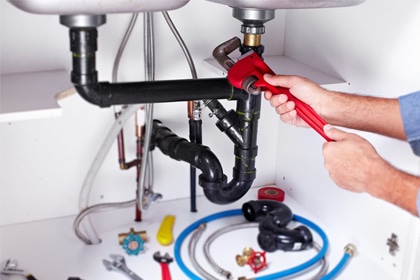
Without knowing the specifics of your remodel, you can budget around $1500-2000 per fixture that you plan to move or add to your kitchen. That’s a general ballpark figure. If the work requires opening up the ceiling below, you will trigger some drywall repairs and painting to make that look new again. Of course, if your project already requires the floors to be opened up, this won’t be as much of a factor.
electrical / Lighting
Before we get into more specifics, a typical budget is around $3000-4000 for electrical. This will include transitioning from something like track lighting to recessed lights, GFCI wall outlets, and the junction boxes ready to receive any pendant lights you pick out on top of that budget.
One popular choice is to invest in under cabinet lighting. Most units of this type are relatively inexpensive because they are more function over style. To have the junction boxes and lights installed you can probably add anywhere from $800-1200 plus the cost of the lights themselves.
Pro Tip: Know your electrical panel!
One factor that most people don’t budget for in advance is a panel upgrade. Depending on how many amps you are adding to the electrical system, you may trigger a required panel upgrade. If your project will require a panel upgrade, the cost might range anywhere from $900 to $3500 with the average panel upgrade running around $2000

Flooring
This is one item which can be almost completely optional. If you’re happy with your flooring and don’t plan to move walls, remove an existing island or peninsula, or change the layout of the kitchen then you may not need to spend any money at all on flooring.
To get an idea of new flooring costs, we recommend that you get in touch with us (or your contractor) and talk over the possibilities and specifics. There are many websites and flooring distributors who can also give you some costs per square foot. Frankly, we would be happy to list the many options here and the costs associated, as well as pros and cons for each of them. However, that is almost enough for a separate article.
Tile Backsplash
While this is also optional, most people like the look and functionality of a tile backsplash between their counters and upper cabinets. Like everything else, the cost of this will depend on your choice of tile and square footage. On average you can budget somewhere in the neighborhood of $2500 for labor to install a tile backsplash in a medium sized kitchen. Add to that your choice of tile, and multiply by square footage.
Drywall
It’s almost an afterthought when considering everything else that we have covered here, but the finishing touches matter. If you have gone with a modest remodel and simply replaced the existing cabinetry with new upper and lower units, and no walls needed to be opened up (for plumbing, electrical, HVAC, or gas lines) then drywall work may be completely avoidable.
In our experience that isn’t often the case, and at least some repairs will need to be made to the walls to match the existing surfaces. How much to budget for this is really hard to throw a number at without talking specifics. If you have added or removed a window you will also need to allow for some framing and trim work both inside and out.
The good news is that the cost of drywall will most likely be on the lower end of your budget spectrum. If you’re trying to guess at it for budget purposes before talking your contractor, plug a number like $2500 into your spreadsheet just to be safe (assuming no major wall openings are planned).
Paint
Painting isn’t terribly expensive (relatively speaking), but it does take a fair amount of time and preparation. If you’re running out of budget, it’s probably the one job that most homeowners feel confident to do themselves. However, if you’re like many hard working homeowners, you just want the kitchen to be ready to host your dinner party and not more work to do on the weekend.
If you would like the kitchen to be primed and painted professionally, budget around $900-1800+. Yes, that’s a big range, but there will most likely be texture to match, and the walls of a kitchen often run into the dining room or adjacent areas.
Total costs
Ready for some total numbers?
The national averages on a kitchen remodel are lower than Seattle. The cost of living and property values here are quite a bit higher, as you’re probably well aware. This affects the final price due to overhead like salaries, transportation, and supplier costs.
According to The Seattle Times, the average cost of a kitchen remodel is $145k compared to the national average of $131k. While we understand how averages work, our experience has generally been working with budgets significantly lower than that.
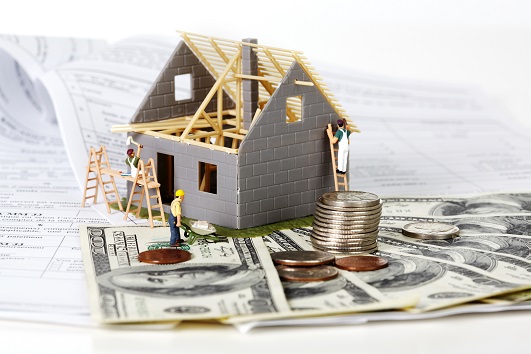
On the lower end to mid range you can expect to pay anywhere from $18-50k.
This would cover small spaces or replacing the cabinet doors and hardware, as opposed to new cabinets. Or perhaps you only choose to upgrade a few key items while keeping some of your existing appliances and features. This budget range might allow for a pass-through window, rather than removing a wall to create an open kitchen design.
We have seen plenty of Youtube videos where people just replaced their cabinet hardware and faucet, then paint the walls or add a laminate backsplash. They claimed to have “remodeled their kitchen for under $1500”. In our opinion that’s sprucing it up a bit, but it’s hard to call it a remodel.
Most true “kitchen transformations” will on average be between $50-80k
For this budget you can probably get most, if not all of the big ticket items that you were hoping for. This budget may also allow for removing part or all of an interior wall to open the kitchen up to the rest of the house. For a project in this range you probably won’t believe it’s the same kitchen, and it’s going to add a real “wow” factor to your house.
If you’re shooting for the moon budget between $80-125k
This type of option will easily give you a one of a kind custom kitchen worthy of a magazine cover. A project with this kind of budget may also include extending the exterior walls of the house and increasing your square footage. This type of ‘showcase kitchen’ is for people who love to entertain and spend a lot of time in their kitchen. The only danger here is that the rest of the house may start to pale in comparison. The solution for that of course, is doing the bathrooms too!
The happy middle road: $35-60k
In our experience most clients on a budget attempt to do a bit of both worlds. By this we mean that they might opt for a few of the big ticket items that really make the kitchen stand out, while possibly holding off on some upgrades until a later date. This can totally work if done right. You can keep using your fridge and dishwasher for a few more years as long as you make sure that the model you plan to buy down the road will fit later on. The same goes for lighting fixtures, tile backsplashes, and nice cabinet hardware.
We work with our clients to help them stay on budget and offer our advice on where they can save. We also do our best to keep them informed on how to plan if they are staggering their remodel in stages.
ROI: What increase can you expect in property value
Is it all worth it?
If you haven’t suffered from ‘sticker shock’ and you’re still reading, one of your next questions will probably be what kind of return on your investment can you expect to see from a project like this?
We asked Shelly Miller, a local Seattle real estate broker with Windemere, and here’s what she said.
“Kitchens and bathrooms sell houses. The majority of buyers don’t want to tackle a kitchen remodel. A fresh face in the form of an updated kitchen is inviting, and makes a home ‘pop’ on first impression.”
Shelly has worked in real estate for 30 years, including 15 years as an appraiser before becoming a broker so she really knows her stuff.
When it comes to the ‘ROI’ of a kitchen upgrade, we want to be clear that only a real estate appraiser can give you an accurate figure for your specific situation. While we can only speak in generalizations, our anecdotal research shows that you can expect to double your investment (or more) if you do it right.
Obviously if you ‘go cheap’ then potential buyers are going to notice that, and your new kitchen may fail to impress. At the same time, if you overspend on things that you love but not everyone appreciates, you may not see as high of a return proportionally for your investment.
At the end of the day, it comes down to why you’re remodeling your kitchen, and who it is for. If you have no plans to sell anytime in the near future then the ‘ROI’ will be years of enjoyment.
That’s hard, if not impossible to put a price on.
